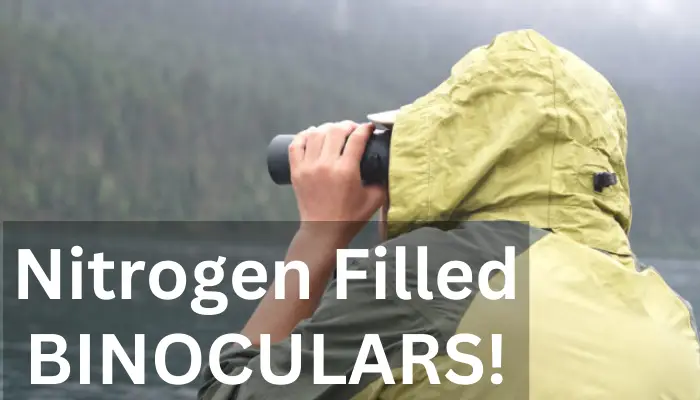This post may contain affiliate links which means I may receive a small commission for purchases made through the links. Learn More
Modern binoculars come with a special tag of ‘‘nitrogen gas purged’’ and it sounds a bit confusing. Especially if you’re new to the optics, then the chances are high that you would be confused about the nitrogen purging in the binoculars.
Don’t worry, it’s not only you. In fact, many people don’t understand the fancy terms and the purposes behind the usage of different technologies. Why are binoculars filled with nitrogen gas? This is going to be our topic.
Almost all modern binoculars come with nitrogen gas purging as the purged nitrogen (Highly pressurized nitrogen) doesn’t allow moisture and other dust particles to come inside the binoculars and destroy the lens.
It was just an introductory answer, but I have a lot more to tell you about. After reading this guide, you’ll be able to understand everything about nitrogen-purged binoculars. Let’s get started.
Related Article: How to keep binoculars from fogging up?
Why are modern binoculars filled with nitrogen gas?
Binoculars are tools that are used for outdoor activities and if they are exposed to different weather conditions then the chances are high that moisture and other contaminants go inside them and destroy the lenses of binoculars. A bad impact on the lens means that your binoculars won’t be working properly as the lenses are the most important components.
In previous times, when binoculars were not purged with nitrogen or with any other gas then the moisture was used to destroy the binoculars by going inside them and creating a mess with the lenses of binoculars. But with the purging of nitrogen gas, modern binoculars face no issue when they make contact with water or moisture, or dust particles.
The nitrogen purging is done by keeping the gas at very high pressure to ensure that it does not allow the contaminants to go inside the binoculars. The o-ring sealing further supports the nitrogen gas purging and makes it literally impossible for the fog, moisture, or dust particles to go inside the optics
How are binoculars purged with nitrogen?
The nitrogen gas is filled before the assembly of different optical components. At the factors, the nitrogen gas is pressurized and filled in the binoculars and after the filling, different optical components are assembled.
This filled nitrogen gas makes the interior of binoculars very dry and removes all the moisture and dust particles if any are present. After the optical components are assembled the o-ring sealing is used to ensure that the gas does leak or move out.
This process is done by the experts and they fill the gas by keeping the pressure very high. Doing so helps them in avoiding the mixing of nitrogen gas with any other as oxygen, carbon dioxide, and many other gasses are also present in the environment.
Also Read: Are Binoculars Bad for Your Eyes?
Nitrogen or non-nitrogen binoculars?
If you’ve read the above section then you should not be confused about which one is better: either nitrogen-purged or non-purged binoculars. When you choose binoculars purged with nitrogen then you can use them in outdoor conditions even in rain and they will be perfectly fine as the moisture, water, and other contaminants won’t go inside them.
But when you choose binoculars with no proper purging then you have to compromise and take extra care to keep them away from moisture. In case moisture makes any contact with them, then you will see the fogging of lenses. Using them in slightly harsher outdoor conditions will be out of the question. So does it make sense to choose outdoor tools that cannot be used in outdoor conditions? Think twice!
Key Takeaways: Nitrogen-purged binoculars are always a better and safer option and you can be confident while using them in the rain or in fog. The moisture and dust particles won’t go inside them to create problems. Choosing a non-purged binocular is nothing but regret.
Benefits of Nitrogen purged binoculars
I hope that you’re having a better understanding of the basics of the purging process. So, let’s have a look at some potential advantages that you are going to get if you choose nitrogen-purged binoculars;
- Nitrogen removes all the impurities when the optical components are assembled
- No moisture and other contaminants go inside the nitrogen-purged optics
- You will be able to use nitrogen-purged binoculars in rain and fog
- The fungus that usually grows in moist environments stay away from your binoculars
- The purging keeps binoculars’ lenses away from fogging up.
Are Non-nitrogen-Filled Binoculars Worth Your Money?
This question has been asked many times on different platforms. This guide actually revolves around this and I have explained everything in detail that binoculars that have no purging are literally useless. No non-nitrogen-filled binoculars are worth your money. I am sure that after reading the whole guide and the advantages of purging, you’ll also be convinced that purging of gas is inevitable.
Nitrogen vs Argon gas purging – Which one is better?
There are different gasses that are being used for the purging process. However, nitrogen and argon gasses are the two most common gasses that almost all the optics brands use nowadays. Choosing gas other than these two to make binoculars is very pricy so the manufacturers only use two gasses; argon and nitrogen.
But the question is which is better between nitrogen and argon purging. To be honest, argon gas purging is a lot better than nitrogen in many ways. But you’ll see almost all the binoculars coming with nitrogen purging. The reason is that nitrogen gas has a very low price and it makes binoculars cheaper.
But argon gas is the least reactive and it does make any contact with any other gas and making it literally impossible for the impurities to come inside the binoculars. On the other hand, nitrogen is slightly reactive and does work as well as argon gas does. But the slightly higher price of argon makes it a less cost-effective method.
Almost all the premium binoculars with higher prices come with argon purging and you can use such binoculars in heavy rain without any problem. With nitrogen binoculars, you will have to take slight care by not using them in heavy rain. However, nitrogen-purged binoculars do a decent job.
Frequently Asked Questions
The major reason behind filling binoculars with nitrogen gas is to keep your binoculars safe from the moisture, water, dust particles, and other contaminants that can go inside the binoculars and destroy your binoculars.
No, you cannot fill nitrogen in your binoculars. It is complex and only manufacturers can fill the gas as they pressurize the gas and then seal it properly.
You can check the binocular box or read the user manual to see if your binos have nitrogen purging or not. There is no other way to check if the binoculars are purged or not.
Yes, binoculars that have proper pouring can be used in cold weather, even in the rain and fog.
Conclusion
I hope that you now have a better understanding of nitrogen gas purging. It is done to safeguard and protects your binoculars from moisture and dust particles. In the past, binos did not come with purging and the users faced many issues. Luckily, with the advancement of technology, things have changed and almost all modern binoculars come with nitrogen or argon gas purging.

I’m a passionate outdoor activist who has got special love for optics. The school studies in optical mechanics and the travelling experience has made me an expert in optics like binoculars, scopes, and other devices. Stay connected with us for in-depth knowledge!

